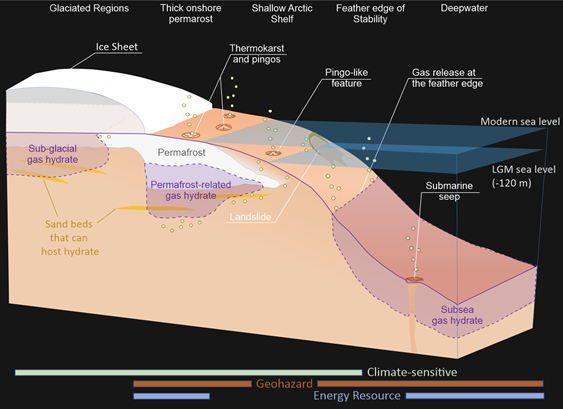Cryosphere associated gas hydrates in climate change:
Risks and Chances
Natural gas hydrates are ice-like, crystalline solids composed of water and gas molecules. Water molecules form defined cage structures via hydrogen bonds, which are connected to a three-dimensional network. The cages are stabilized by the encasement of a mostly non-polar guest molecule, mainly methane but also other hydrocarbons, and other gases, such as CO2. Natural gas hydrates form at elevated pressure and low temperature conditions and occur at all active and passive continental margins but also in polar regions within or below permafrost as well as in the shallower parts of the Arctic Ocean and beneath large ice sheets.

Natural gas hydrate deposits in polar regions are in danger, as polar regions are warming faster than the rest of the planet leading to drastic and cascading environmental impacts including ice shield and glacier melting, sea ice decline, and rapid permafrost thawing. These changes in the environment can lead to the decomposition of natural gas hydrate deposits and thus to the release of large quantities of climate-active methane. How large these quantities will be is at present still unknown: Current estimates of the methane stored in these environments ranging from 27 to 800 gigatons of methane, whereas older studies even suggest up to several thousand gigatons.
Despite the potentially large methane stores, cryosphere associated gas hydrates are currently understudied. The magnitude, location and temporal evolution of hydrate dissociation rates, as well as of resulting methane emissions to the atmosphere over the next decades and centuries are unknown. Consequently, polar hydrates are not included in global budgets, climate and global assessment models and thus absent from policy discussions. However, polar hydrates have the potential to release significant and increasing methane emissions into the atmosphere with warming and thus also contribute to the aforementioned risks to polar infrastructure and health, trigger geohazards and negatively impact ecosystems. It is therefore urgently necessary to close the knowledge gaps described below in order to enable reliable predictions.
The Gas Hydrate Community Scoping Workshop “Permafrost Gas Hydrates in Climate Change: Risks and Chances”, as convened in Hanover, Germany over July 3-5, 2024, identified a series of integrated gas hydrate science and technical challenges as the central themes:
- Quantifying the methane stored in the global permafrost associated gas hydrate systems,
- Assessing what portion of the global permafrost associated gas hydrate is at risk of dissociation,
- Understanding the fate of the methane released from these gas hydrate systems, and
- The development and integration of modeling, laboratory, and field geologic, geophysical, geochemical, and geo-mechanical measurements needed to identify and characterize the geological controls on the occurrence and stability of cryosphere associated gas hydrates in nature.
To overcome these challenges, we propose the following strategy and approach:
The proposed approaches are essentially based on three pillars:
Data mining and modeling: with existing data a carbon budget resource map specific to cryosphere related gas hydrates should be developed. Based on these results drilling campaign will be planned. Additional modeling with new field and lab data enables the prediction for future developments.
A land-to-sea drilling campaign. Such a drilling campaign offers an unprecedented opportunity to obtain crucial data and information on the ongoing degradation of permafrost and the gas hydrates it contains, as well as to determine current greenhouse gas emissions and derive projections for future risks
An interdisciplinary and coordinated global collaboration on laboratory experiments to determine the influence of various parameters on the dissociation kinetics of gas hydrates, the associated amount of methane released and the fate of the emitted gas. These data are essential for a realistic estimation of the amount of methane that could potentially be released into the atmosphere. Changes in the properties of hydrate-bearing sediments with decreasing hydrate content are also of great importance for risk assessments.
For successful realization, it is essential that the work of all contributing scientists will be coordinated and the data exchanged so that the laboratory data can meaningfully complement the field data and be incorporated into the models.
